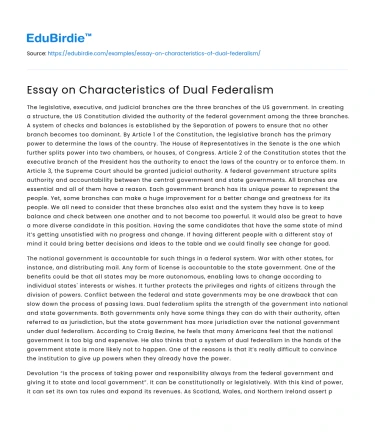Introduction
Dual federalism, often referred to as "layer cake federalism," is a critical concept within the realm of political science and constitutional law. This framework delineates a clear division of responsibilities and powers between national and state governments, akin to layers of a cake that remain distinct yet part of a unified whole. Originating in the United States during the late 18th and early 19th centuries, dual federalism was predicated on the belief that governmental powers should be separated to prevent tyranny and protect individual liberties. The Constitution's Tenth Amendment, which reserves powers not delegated to the national government to the states or the people, underscores this principle. Despite its foundational role, dual federalism has evolved and faced challenges over time, particularly during periods of national crisis and social change. This essay explores the characteristics of dual federalism, examining its historical context, practical implications, and criticisms, ultimately providing a comprehensive understanding of its role in shaping governmental structures.
Historical Context and Core Characteristics
Dual federalism emerged in the United States as a response to the need for a balanced distribution of power between national and state authorities. This system is characterized by a clear demarcation of governmental functions, with each level of government operating independently within its sphere. One of the most illustrative examples of this is the distinction between federal and state responsibilities as outlined in the Constitution. For instance, the federal government handles matters of national defense, foreign policy, and interstate commerce, while states retain control over education, local law enforcement, and intrastate commerce.
Save your time!
We can take care of your essay
- Proper editing and formatting
- Free revision, title page, and bibliography
- Flexible prices and money-back guarantee
A significant real-life case that exemplifies dual federalism is the landmark decision in McCulloch v. Maryland (1819), where Chief Justice John Marshall upheld the supremacy of federal law over state law, reinforcing the notion that powers not explicitly granted to the federal government were reserved for the states. This decision highlighted the dual nature of federalism, where both levels of government have sovereignty within their respective domains. As political scientist Daniel Elazar notes, "Federalism involves the combination of shared rule and self-rule," capturing the essence of dual federalism's operational framework.
However, the rigid separation of powers inherent in dual federalism has been both a strength and a weakness. On one hand, it has preserved state sovereignty and fostered diversity in policy approaches. On the other hand, it has sometimes led to inefficiencies and legal conflicts when state and federal interests clash. This duality is a fundamental characteristic that defines the complexity and adaptability of dual federalism as a governing model.
Implications and Evolution Over Time
While dual federalism provided a foundational structure for the early United States, its application has evolved significantly over time. The Civil War era marked a turning point, challenging the rigid boundaries of state and federal powers. The post-war amendments, particularly the Fourteenth Amendment, expanded federal authority to protect individual rights against state infringement, indicating a shift towards cooperative federalism.
Despite these changes, dual federalism's principles continued to influence American governance. For example, during the New Deal era, the Supreme Court initially resisted President Franklin D. Roosevelt's expansive federal programs, citing dual federalism principles before eventually acquiescing to broader federal involvement in economic regulation. This period illustrates the adaptive nature of dual federalism in response to national exigencies, highlighting the balance between maintaining state autonomy and addressing collective needs.
The debate over dual federalism persists in contemporary discourse, particularly in areas such as healthcare and environmental regulation. The Affordable Care Act's implementation, for instance, raised questions about the extent of federal power over state-administered programs, reflecting ongoing tensions within the dual federalism framework. As legal scholar Barry Friedman asserts, "Federalism remains a dynamic interplay of state and federal interests," emphasizing the enduring relevance of dual federalism in navigating complex policy landscapes.
Criticisms and Counterarguments
Despite its foundational role, dual federalism has faced significant criticisms, particularly regarding its practicality in addressing modern governance challenges. Critics argue that the strict separation of powers can hinder effective policy implementation and lead to inconsistencies across states. This fragmentation is evident in areas such as civil rights, where state-level disparities have prompted federal intervention to ensure uniform protection of rights.
Moreover, the complexity of contemporary issues often necessitates collaborative approaches that transcend traditional boundaries. For instance, climate change and cybersecurity are global challenges requiring coordinated efforts across all levels of government, challenging the rigid nature of dual federalism. These criticisms underscore the need for a more integrated model of governance that facilitates cooperation and synergy between state and federal authorities.
However, proponents of dual federalism argue that its structure is essential for preserving state sovereignty and fostering innovation through localized policy experimentation. They contend that a decentralized approach allows states to serve as "laboratories of democracy," testing diverse solutions to complex issues. As political philosopher Alexis de Tocqueville observed, "The federal system was created with the intention of combining the different advantages which result from the magnitude and the littleness of nations," highlighting the potential benefits of maintaining distinct governmental layers.
Conclusion
In conclusion, dual federalism remains a pivotal concept in understanding the division and interaction of governmental powers within the United States. Its historical evolution, characterized by a clear separation of state and federal responsibilities, has shaped the nation's governance framework. While dual federalism has faced criticism for its rigidity and potential inefficiencies, it also offers valuable insights into preserving state autonomy and fostering policy diversity. The ongoing discourse surrounding dual federalism reflects its adaptability and relevance in addressing contemporary challenges. As the United States continues to navigate complex policy landscapes, understanding the characteristics and implications of dual federalism is crucial for scholars, policymakers, and citizens alike. By examining its historical context, practical applications, and criticisms, we gain a comprehensive perspective on the enduring influence of dual federalism in shaping the dynamics of American governance.






 Stuck on your essay?
Stuck on your essay?

